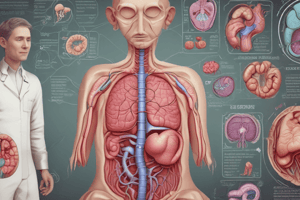Podcast
Questions and Answers
What is the recommended rate of intravenous fluids during the preoperative period?
What is the recommended rate of intravenous fluids during the preoperative period?
- 120 ml/kg/day of 0.9% NaCl + 5% dextrose
- 200 ml/kg/day of 0.9% NaCl + 5% dextrose
- 100 ml/kg/day of 0.9% NaCl + 5% dextrose
- 150 ml/kg/day of 0.9% NaCl + 5% dextrose (correct)
What is the primary goal of resuscitation in the preoperative period?
What is the primary goal of resuscitation in the preoperative period?
- To restore adequate blood glucose levels
- To ensure normal blood test results before surgery (correct)
- To achieve proper hydration within 24 hours
- To correct electrolyte imbalance
What is the surgical procedure performed to treat pyloric stenosis?
What is the surgical procedure performed to treat pyloric stenosis?
- Gastric Bypass Surgery
- Duodenal Repair
- Intestinal Resection
- Ramstedt's Operation (Pyloromyotomy) (correct)
What is the recommended postoperative feeding schedule?
What is the recommended postoperative feeding schedule?
What is a possible complication of incomplete pyloromyotomy?
What is a possible complication of incomplete pyloromyotomy?
What is the recommended duration of intravenous antibiotics administration in cases of duodenal perforation?
What is the recommended duration of intravenous antibiotics administration in cases of duodenal perforation?
What is the incidence of Pyloric Stenosis in live births?
What is the incidence of Pyloric Stenosis in live births?
What is the risk factor for Pyloric Stenosis if the mother is affected?
What is the risk factor for Pyloric Stenosis if the mother is affected?
What is the characteristic of the pyloric canal in Pyloric Stenosis?
What is the characteristic of the pyloric canal in Pyloric Stenosis?
What is the effect of Pyloric Stenosis on gastric outlet obstruction?
What is the effect of Pyloric Stenosis on gastric outlet obstruction?
What is the typical postnatal age of onset for symptoms of Pyloric Stenosis?
What is the typical postnatal age of onset for symptoms of Pyloric Stenosis?
What is the characteristic of vomiting in Pyloric Stenosis?
What is the characteristic of vomiting in Pyloric Stenosis?
What is the compensatory response to gastric outlet obstruction in Pyloric Stenosis?
What is the compensatory response to gastric outlet obstruction in Pyloric Stenosis?
What is the effect of Pyloric Stenosis on electrolyte balance?
What is the effect of Pyloric Stenosis on electrolyte balance?
Which one is a pathognomonic sign for hypertrophic pyloric stenosis (IHPS)?
Which one is a pathognomonic sign for hypertrophic pyloric stenosis (IHPS)?
What symptom is common to both gastroenteritis and milk protein allergy?
What symptom is common to both gastroenteritis and milk protein allergy?
In the diagnosis of IHPS, which muscle thickness measurement on abdominal ultrasonography is indicative of the condition?
In the diagnosis of IHPS, which muscle thickness measurement on abdominal ultrasonography is indicative of the condition?
Which blood test result is typically NOT associated with IHPS?
Which blood test result is typically NOT associated with IHPS?
What is the primary purpose of resuscitation in the management of pyloric stenosis?
What is the primary purpose of resuscitation in the management of pyloric stenosis?
Which diagnostic method is comparable to seeing a 'hot dog in a bun' appearance?
Which diagnostic method is comparable to seeing a 'hot dog in a bun' appearance?
Which condition is characterized by acidosis rather than alkalosis?
Which condition is characterized by acidosis rather than alkalosis?
Why might gastric decompression by a nasogastric tube not typically be required in pyloric stenosis?
Why might gastric decompression by a nasogastric tube not typically be required in pyloric stenosis?
Flashcards are hidden until you start studying




